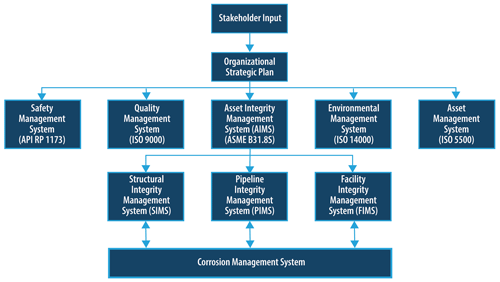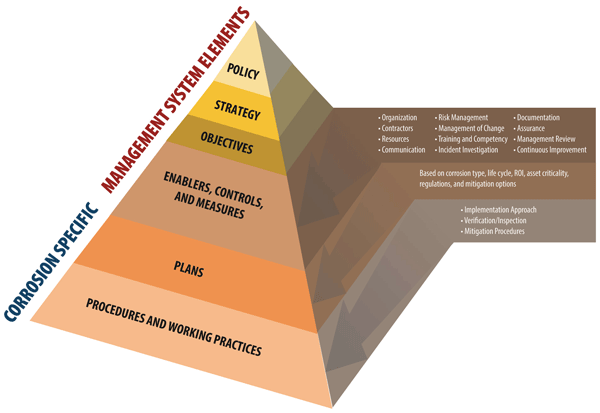Over past decades, there have been significant studies in various parts of the world on the cost of corrosion and how it affects a country’s economy. The often cited 2002 study, “Corrosion Costs and Preventive Strategies in the United States,”1 revealed that the total annual estimated direct cost of corrosion was $276 billion—equivalent to approximately 3.1% of the U.S. gross domestic product (GDP). Studies in other countries have shown a similar percentage of GDP.
Over the last two years, NACE International embarked on a new study that goes beyond the economic effects of corrosion; it emphasizes how to integrate corrosion technology with organizational management systems to optimize corrosion decisions with respect to both cost savings and concern for safety and the environment. IMPACT—the International Measures of Prevention, Application, and Economics of Corrosion Technologies study—is now available to the general public at impact.nace.org.
IMPACT focuses on segments of four major industries: energy, utilities, transportation, and infrastructure. The study features in-depth research and resources in these areas:
• Assessment of the global cost of corrosion
• The Corrosion Management System Framework, a documented set of processes and procedures required for planning, executing, and continually improving the ability of a company to manage the threat of corrosion for new and existing assets
• Assessment and benchmarking of existing corrosion management practices, including case studies and survey results from hundreds of companies
• Corrosion management tools such as lifecycle costing
• Education and training programs and opportunities
• Preventive strategies for effective corrosion management
NACE formed a panel of three IMPACT study and pipeline experts who answered a series of questions on findings related to the pipeline industry. They are Gerry Koch, David Kroon, and Oliver Moghissi.
NACE: The IMPACT report states that the most significant outcome of the study is that reducing what continues to be an astoundingly high cost of corrosion (US$2.5 trillion globally) requires a change in how corrosion decisions are made in an organization. Can you please provide your perspective on this, in particular for the pipeline industry?
Gerry Koch (GK): With the current global reduction in oil prices affecting the operating budgets of many oil/gas and pipeline operators, the need for corrosion control measures to maintain assets has not correspondingly decreased. To maintain the degree of corrosion control that was possible under more favorable economic conditions, direct comparison between corrosion control and other unrelated expenses is essential.
Oliver Moghissi (OM): In the future, corrosion decisions will increasingly be made on the basis of economic arguments, which can include risk through monetization of consequences. This will allow direct comparison between corrosion control and other unrelated expenditures by those with authority to approve funds. Most corrosion decisions are currently based on technical requirements, causing decision-makers to emphasize compliance over financial optimization.
The conflict surrounding NACE SP01692 with respect to how cathodically polarized potentials should be measured is an example of how our profession can improve. The next revision of the standard would be better served by focusing on how external pipeline corrosion management can be optimized within an integrity (or asset risk) context. This larger goal would then allow more flexibility in technical execution.
David Kroon (DK): The risk of corrosion and how to manage that risk needs to be an important part of the organization’s asset management program. It is not simply a compliance issue. It is an integral part of safety, environmental protection, and asset integrity management. This requires that related matters are considered and discussed during strategy sessions led by senior management. Implementation of a corrosion management system (CMS), which may take the form of a stand-alone system or incorporation into the organization’s asset management system, is essential. How to measure the cost and the benefit of the corrosion management activities needs to be agreed upon, including the process to collect the data. Senior management must champion the effort, establish the business case, and measure the effectiveness. The easy part is identifying the technical tools to use for corrosion control.
NACE: A core deliverable of the IMPACT study is the CMS Framework, a set of policies, processes, and procedures for planning, executing, and continually improving the ability of an organization to manage the threat of corrosion for existing and future assets (see Figures 1 and 2). What needs to happen in a pipeline company to achieve the effective implementation of a CMS?
OM: Two things need to happen to implement a CMS. The first is that the CMS needs to be integrated within an existing management system as a normal business activity. The second is that representatives from all levels of the organization must choose to adopt it; the corrosion professional will likely experience the most cultural change.

DK: Senior management must drive the process. Corrosion management must be made a priority and included in the policies, strategies, and objectives of the organization. The first step is to define the corrosion risks. Then, define how to reduce those risks, the metrics for measuring improvements, and calculating the return on investment (ROI).

NACE: Onshore pipeline operators from several countries were surveyed and their corrosion management programs benchmarked according to nine management system domains: policy, including strategy and objectives; stakeholder integration; organization; accountability; resources; communication; corrosion management practice integration; continuous improvement; and performance measures. They consistently scored lowest on policy and performance measures, and to some extent stakeholder integration. Can you explain how and why this occurs?
GK: Corrosion control is often seen as a maintenance activity or at best, as part of asset integrity, which is often more linked to an operator’s business management systems. However, corrosion control is likely not seen as part of higher management domains, which could be the reason for low scoring on policy and performance measures.
DK: If you can’t measure it, it doesn’t count. Corrosion management is often not included as part of the organization’s strategic plan. What “corrosion management” means to each operator needs to be defined. Objectives must be established with metrics identified. Then, measure the benefit and calculate the ROI.
OM: Corrosion technology currently sits within plans, procedures, and working practices and is not normally incorporated within higher management system domains. A shift toward corrosion management that incorporates technology will allow the technology to have a higher role.
NACE: What comments do you have on the other management system domains listed in the previous question?
OM: The corrosion professional community will experience a cultural change. It is unrealistic to expect managers within higher management system domains to learn the language of corrosion technology. Rather, the corrosion professional must become fluent in the language of those domains.
DK: Corrosion management should be an integral part of the continuous improvement process, including prioritization and allocation of resources. When the CMS is demonstrated to benefit the company, celebrate the success.
I have been a corrosion control practitioner all of my career. It still amazes me how late in the design process the application of corrosion control technologies is considered. This should always be an integral part of preliminary engineering and addressed in the preliminary engineering report.
NACE: The report stresses the importance of having buy-in on a CMS from all levels of an organization. In your experience what are the challenges involved with this?
GK: All levels of an organization must have the long-term vision that corrosion control can be considered an investment into the asset rather than an expense.
DK: Corrosion management rarely results in an immediate benefit to the company with visible impact on quarter-over-quarter and year-over-year financial performance. Investors only recognize the real costs of corrosion when incidents occur that are harmful to public safety, the environment, and/or adversely affect financial performance due to the cost of repair, lost production, and reduction in the life of the asset. The benefits are more difficult to recognize and monetize—safer operations, fewer failures, reduced risk leading to reduced liability, and a lower life-cycle cost of the asset.
OM: The difficulty comes from the inability of those accountable for enterprise risk to quantify the impacts of corrosion and the benefit of corrosion control investment. Once we incorporate corrosion control within an existing management system and monetize the impacts, corrosion-related expenditures can be optimized.
NACE: Please provide any additional comments about the IMPACT findings as they pertain to the pipeline industry.
DK: IMPACT contains a great deal of good information and guidance for establishing (or improving) a CMS. There are two related items that I think should be emphasized. The first is metrics. How will the success of the program be measured? This requires not only establishing key performance indicators but also capturing costs along the way that are not typically captured within an operation. Examples would be indirect costs and cost avoidance. This type of data is very difficult to recreate after the fact so a process needs to be in place to regularly capture the data. The second issue is how will ROI be calculated? What will be the input data for investment and return?
GK: In many companies, “corrosion” is seen is as a career with little future and young engineers who start their career in corrosion often jump over to careers with more potential advancement. If corrosion management can become part of an organization’s overall business management system, career mapping as part of a management system could create a more promising career path for aspiring young corrosion engineers.
OM: Corrosion professionals have historically been individual technical contributors with restricted upward mobility within their employer’s organization. Once we adopt the language of management systems, new roles for corrosion professionals will emerge that include greater responsibility (and accountability) within an organization.
References
1 G.H. Koch, M.P.H. Brongers, N.G. Thompson, Y.P. Virmani, J.H. Payer, “Corrosion Costs and Preventive Strategies in the United States,” FHWA-RD-01-156 (McLean, VA: FHWA, 2002).
2 NACE SP0169, “Control of External Corrosion on Underground or Submerged Metallic Piping Systems” (Houston, TX: NACE International, 2013).
This article was originally published in the March 2016 issue of Pipeline & Gas Journal.